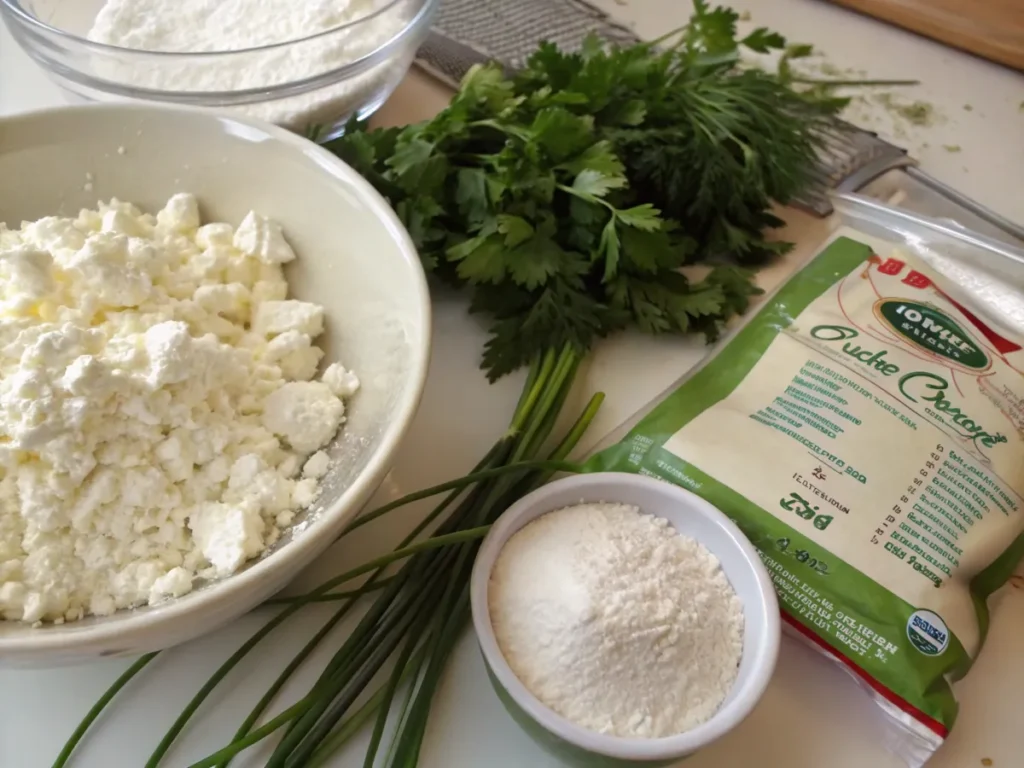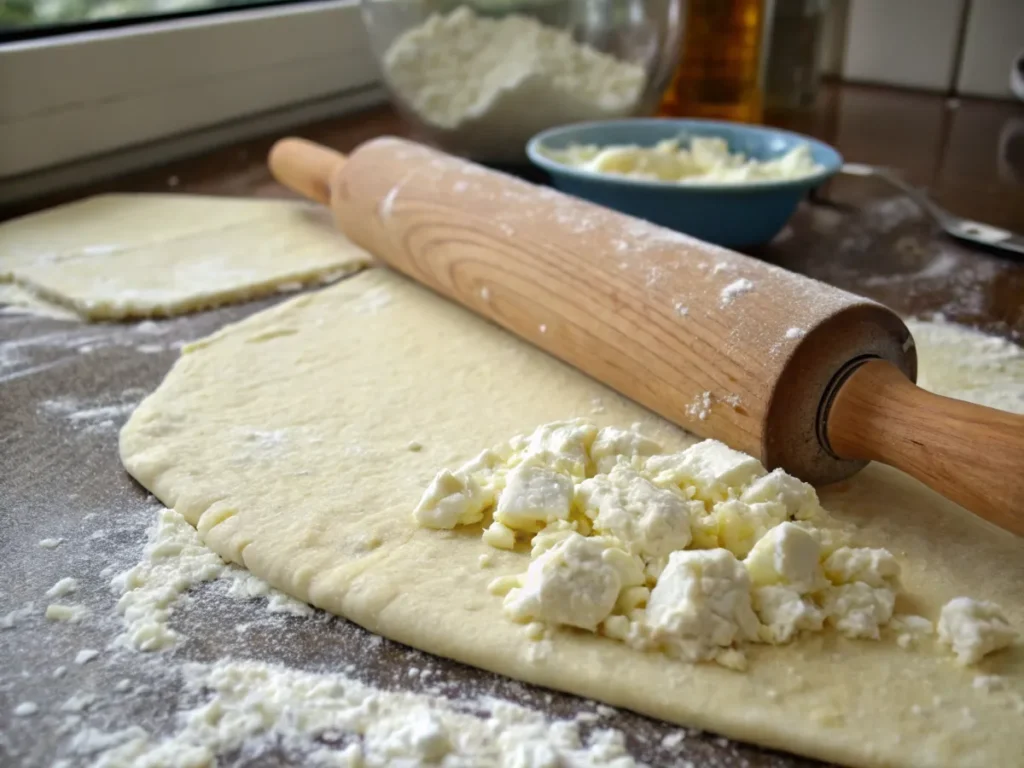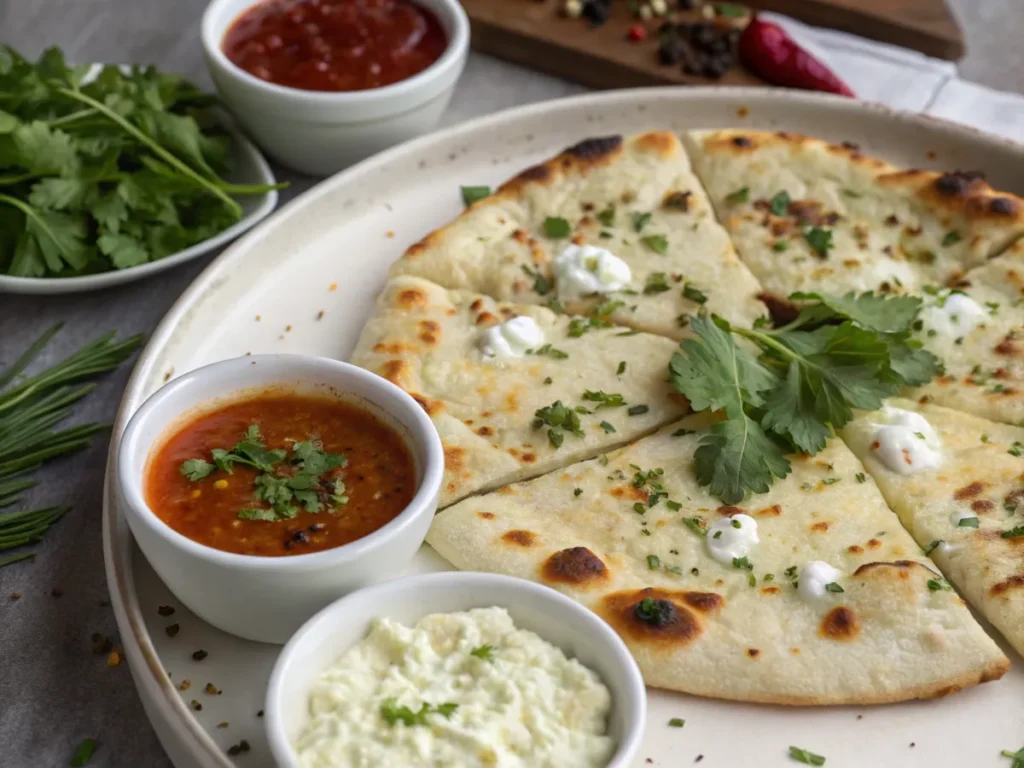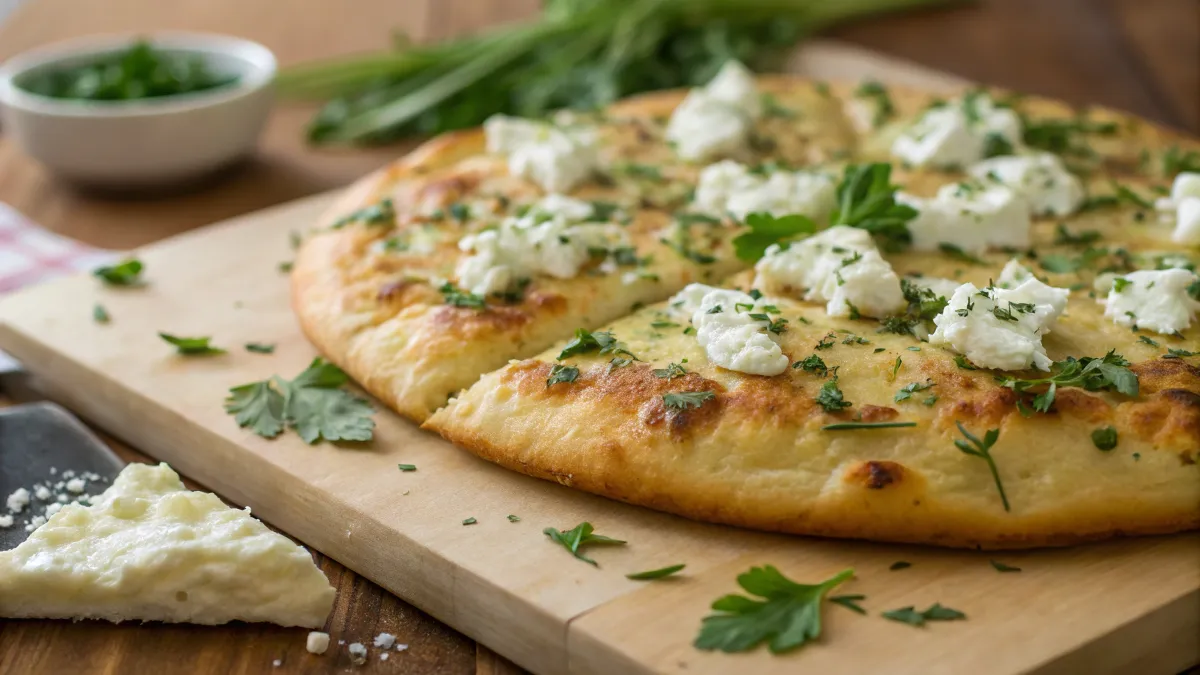There’s something magical about homemade flatbread. It’s soft, warm, and just the right mix of chewy and crispy. Now, imagine taking that classic comfort and giving it a healthy twist with cottage cheese. Yes, you heard that right—cottage cheese flatbread! This recipe is easy, versatile, and high in protein, making it the perfect addition to any meal. Whether you’re whipping it up as a side, a snack, or the base for a pizza night, this flatbread has you covered. Let’s dive in!
Table of contents
Why Cottage Cheese Flatbread is Perfect for Healthy Meals
So, why should you give this recipe a go? Here’s the lowdown: it’s healthy, quick to make, and insanely versatile. Let’s break it down.
Packed with Protein: A High-Protein Flatbread Option
Cottage cheese isn’t just for breakfast bowls and salads anymore. Adding it to flatbread dough brings a protein punch that’s perfect for anyone looking to stay full longer or add more nutrients to their diet. One serving of this flatbread can easily keep hunger pangs at bay for hours.
“Food doesn’t have to be fancy to be nutritious. This flatbread is proof that simple ingredients can do big things.”
Simple and Quick to Prepare
Homemade bread usually sounds intimidating, but this recipe flips the script. No yeast, no waiting for dough to rise, and no complicated techniques. You’ll have warm, fresh flatbread in under 30 minutes. Who wouldn’t love that?
Versatile Base for Endless Toppings
This flatbread is like a blank canvas—perfectly delicious on its own but even better when you dress it up. Want something savory? Add garlic and herbs. Craving something sweet? A sprinkle of cinnamon and sugar will do the trick.
Ingredients for Homemade Flatbread with Cheese
Before you roll up your sleeves, let’s gather the ingredients. The beauty of this recipe is its simplicity. You probably already have most of these in your kitchen.

Key Ingredients for a Healthy Cottage Cheese Bread Recipe
- Cottage Cheese: The star of the show! Use full-fat for extra richness or low-fat for a lighter option.
- All-Purpose Flour: Gives the flatbread its structure. You can also try a gluten-free mix if needed.
- Baking Powder: No yeast? No problem! This helps the flatbread puff up slightly.
- Salt: A little seasoning goes a long way.
Optional Ingredients or Substitutions
- Herbs and Spices: Think oregano, rosemary, or garlic powder for added flavor.
- Cheese: Parmesan or shredded mozzarella can be mixed into the dough for extra cheesiness.
- Gluten-Free Alternatives: Swap regular flour with almond flour or a gluten-free blend for a diet-friendly version.
Tips for Sourcing the Best Ingredients
Fresh ingredients make all the difference here. Go for high-quality cottage cheese (look for minimal additives), and if possible, use organic or unbleached flour. Trust me, these little upgrades can take your flatbread from good to unforgettable.
Step-by-Step Guide to Making Cottage Cheese Flatbread
Now, let’s get to the fun part: making the flatbread. It’s straightforward and doesn’t require any fancy equipment.
Step 1: Preparing the Dough with Cottage Cheese
In a large mixing bowl, combine the cottage cheese, flour, baking powder, and salt. Mix everything together until it forms a soft, sticky dough. If the dough feels too wet, add a little more flour, one tablespoon at a time.
“The dough might stick to your hands at first, but that’s a good sign—it means it’s soft and pliable. Flour your hands lightly to make handling it easier.”
Step 2: Rolling and Shaping the Perfect High-Protein Flatbread
Divide the dough into equal portions (about 4–6 pieces, depending on how large you want the flatbreads). Roll each portion into a ball, then flatten it out using a rolling pin or your hands. Aim for about 1/4-inch thickness.

Step 3: Cooking on the Stovetop or in the Oven
- Stovetop Method: Heat a non-stick skillet over medium heat. Add a little oil or butter, then cook each flatbread for 2–3 minutes on each side, or until golden brown.
- Oven Method: Preheat your oven to 375°F (190°C). Place the flatbreads on a baking sheet lined with parchment paper. Bake for 8–10 minutes, flipping halfway through.
Both methods work like a charm, but if you’re in a hurry, the stovetop is quicker.
Flavor Ideas for Versatile Cottage Cheese Flatbread
One of the best things about this recipe is how adaptable it is. Here are some fun flavor twists to try:
Garlic and Herb Flatbread
Mix minced garlic, dried basil, and parsley into the dough. Top with a drizzle of olive oil after cooking for a savory, aromatic treat.
Cheesy Jalapeño Flatbread
Fold diced jalapeños and shredded cheese into the dough for a spicy kick. Perfect for pairing with soups or chili!
Sweet and Savory Variations for Healthy Flatbread Recipes
Add a teaspoon of cinnamon and a sprinkle of sugar to the dough. After cooking, drizzle with honey or maple syrup for a dessert-like snack.
For a perfectly cooked flatbread, keep the heat even. Need tips? Check out our French Onion Meatloaf Recipe.
“Cooking is all about experimenting. Don’t be afraid to get creative with your flavors—you might just stumble upon your new favorite!”
Expert Tips for Best Results
Making flatbread isn’t rocket science, but a few simple tricks can help you get the best results every time.
How to Achieve the Perfect Texture
Flatbread should be soft, pliable, and slightly chewy. To get there, don’t overwork the dough. Mix just until everything is combined. Over-mixing can make the flatbread tough—nobody wants that!
Avoiding Common Dough Mistakes
- If the dough is too sticky, add a little extra flour gradually.
- If it’s too dry, add a tablespoon of water or milk to bring it back to life.
- When rolling out the dough, dust your surface and rolling pin with flour to prevent sticking.
Tips for Even Cooking
Make sure your skillet or oven is preheated before you start cooking. An evenly heated surface ensures that the flatbread cooks uniformly and gets that beautiful golden brown color.
Pair your flatbread with our Pineapple Casserole Recipe for a fun mix of sweet and savory flavors.
“Flatbread is forgiving—don’t stress if the first one isn’t perfect. By the second or third, you’ll have it down to an art.”
Best Pairings and Serving Suggestions

End your culinary journey with perfectly plated cottage cheese flatbread, ready to serve.
This cottage cheese flatbread is incredibly versatile. Whether you’re serving it as a side, a snack, or the star of the show, here are some delicious ways to enjoy it:
Ideal Dipping Sauces
- Tzatziki: The creamy, garlicky flavor pairs beautifully with the tangy flatbread.
- Hummus: A classic option that never disappoints.
- Spicy Sriracha Mayo: For those who like a little heat.
Great with Soups or Salads
This flatbread shines when paired with hearty soups like lentil or creamy tomato. It’s also great for scooping up fresh salads or serving alongside a protein-packed grain bowl.
Perfect for Parties or Lunchboxes
Cut the flatbread into smaller pieces for easy snacking. Add a variety of toppings or dips to create a fun, interactive meal.
For a perfectly cooked flatbread, keep the heat even. Need tips? Check out our French Onion Meatloaf Recipe.
Storing and Reheating Cottage Cheese Flatbread
One of the best things about this recipe is that it stores well, making it perfect for meal prep or leftovers.
Proper Storage for Freshness
- Let the flatbreads cool completely before storing them.
- Wrap them in foil or place them in an airtight container.
- Store in the refrigerator for up to 4 days or freeze for up to 2 months.
Reheating Techniques to Maintain Quality
- Stovetop: Heat in a skillet over low heat for 1–2 minutes on each side.
- Microwave: Wrap in a damp paper towel and microwave for 10–15 seconds.
- Oven: Wrap in foil and warm at 300°F for about 5 minutes.
Nutritional Information
If you’re curious about what’s in each bite, here’s the breakdown:
Calories and Macronutrient Breakdown per Serving
- Calories: ~150 per flatbread (based on six servings)
- Protein: ~9g
- Carbs: ~18g
- Fat: ~4g
Adjustments for Low-Carb or Keto Diets
- Use almond flour or coconut flour as a substitute for all-purpose flour.
- Skip the baking powder and use a pinch of baking soda with a splash of vinegar instead.
Cottage Cheese Flatbread: Storage, Nutrition & Keto
How Long Does Cottage Cheese Flatbread Last?
Cottage cheese flatbread stays fresh for a few days when stored properly:
- In the Refrigerator: Store it in an airtight container for up to 5 days. If stacking multiple pieces, separate them with parchment paper.
- In the Freezer: Wrap it tightly in plastic wrap, then place it in a freezer bag. It will last up to 2 months.
When ready to eat, reheat it in an oven or air fryer to restore its crispiness.
Can You Freeze Cottage Cheese Flatbread?
Yes, cottage cheese flatbread can be frozen for later use. Follow these steps:
- Let it cool completely before wrapping it.
- Wrap tightly in plastic wrap or aluminum foil.
- Store in a freezer-safe bag and freeze for up to 2 months.
To use, thaw it in the refrigerator and reheat in an oven or air fryer for the best texture.
How Many Carbs Are in Cottage Cheese Bread?
The carbohydrate content in cottage cheese bread varies based on the recipe. Typically, a serving contains around 14 grams of carbohydrates, making it suitable for low-carb diets. However, if additional ingredients such as flour or honey are used, the carb count will be higher.
Why Is Cottage Cheese Not Keto?
While cottage cheese is high in protein, some varieties contain more carbohydrates than recommended for a strict ketogenic diet. This is because some brands add sugars or milk solids, increasing the carb content. To keep it keto-friendly, choose full-fat, plain cottage cheese and monitor portion sizes.
Can I Eat Cottage Cheese That Is 1 Week Expired?
It is not advisable to eat cottage cheese that is a week past its expiration date. Even if it looks and smells fine, harmful bacteria may have developed. Always check for mold, an unusual smell, or a sour taste before consuming. When in doubt, it’s best to discard it to avoid foodborne illness.
Conclusion
This cottage cheese flatbread recipe brings together simplicity, nutrition, and versatility in one delicious dish. Whether you’re looking for a healthy snack, a high-protein side, or a customizable base for your favorite toppings, this recipe has you covered. With easy-to-find ingredients, straightforward steps, and endless flavor options, it’s the perfect addition to your meal rotation.
Ready to try it yourself? Share your creations or favorite variations in the comments below—I’d love to see how you make it your own! Don’t forget to bookmark this page or share it with friends who love experimenting with healthy flatbread recipes.
Looking for more inspiration? Check out our other easy cottage cheese recipes and discover new ways to elevate your cooking game. Let’s keep your kitchen adventures exciting and delicious!
“Cooking doesn’t have to be complicated. Sometimes, the simplest recipes—like this flatbread—can be the most rewarding.”
Cottage Cheese Flatbread FAQ
Cottage cheese flatbread has gained popularity as a high-protein, low-carb alternative to traditional bread. Below are answers to common questions about this flatbread:
Cottage Cheese Flatbread: Health & Preparation
Is Cottage Cheese Flatbread Healthy?
Yes, cottage cheese flatbread is generally considered a healthy option. It is high in protein, low in carbohydrates, and naturally gluten-free. Because it is made primarily with cottage cheese and eggs, it provides essential nutrients while being relatively low in calories. However, the overall healthiness depends on the ingredients used and individual dietary needs. For a healthier version, opt for low-fat cottage cheese and avoid adding excessive oils or toppings.
How to Make Cottage Cheese Flatbread?
Making cottage cheese flatbread is simple and requires minimal ingredients. Follow these steps:
Preheat your oven to 350°F (175°C).
Blend 1 cup of cottage cheese with 2 large eggs until smooth.
Pour the mixture onto a parchment-lined baking sheet and spread it into a thin layer.
Bake for 30-40 minutes until the flatbread turns golden brown.
Let it cool before serving.
For extra flavor, consider adding garlic powder, Italian seasoning, or fresh herbs.
Why Is My Cottage Cheese Flatbread Soggy?
If your flatbread turns out soggy, here are a few possible reasons:
Underbaking: Make sure the flatbread is cooked until firm and golden brown. If needed, bake it for a few extra minutes.
Trapped Moisture: Allow the flatbread to cool on a wire rack instead of leaving it on a warm surface.
Storage Issues: Storing flatbread in an airtight container while still warm can cause condensation, leading to a soggy texture.
To prevent sogginess, bake thoroughly and cool properly before storing.
Can You Make Cottage Cheese Flatbread in an Air Fryer?
Yes, you can make cottage cheese flatbread in an air fryer. Here’s how:
Preheat the air fryer to 350°F (175°C).
Prepare the batter as usual and pour it onto a parchment-lined air fryer basket.
Air fry for 15-20 minutes, checking for doneness.
Let it cool before slicing and serving.
Since air fryer models vary, keep an eye on the cooking time to prevent burning.

